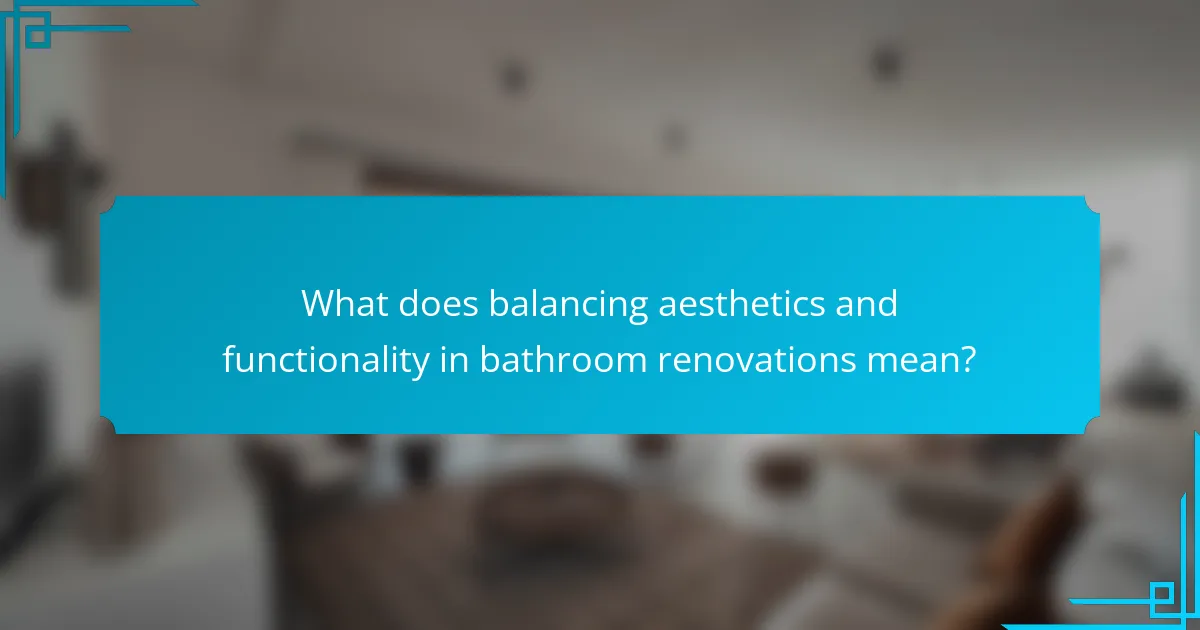Balancing aesthetics and functionality in bathroom renovations involves creating a visually appealing space that meets practical needs. Aesthetics encompass design elements, colors, and materials that enhance the bathroom’s charm, while functionality ensures efficiency and usability for daily activities. Homeowners prioritize both style and practicality, with many valuing beautiful designs alongside essential features like storage and lighting. Challenges such as budget constraints, design inconsistencies, and space limitations can hinder achieving this balance. Best practices for successful renovations include assessing space requirements, selecting durable materials, and incorporating effective lighting and accessible fixtures to enhance user satisfaction and property value.

What does balancing aesthetics and functionality in bathroom renovations mean?
Balancing aesthetics and functionality in bathroom renovations means creating a space that is visually appealing while also serving practical needs. Aesthetics refer to the design elements, colors, and materials that enhance the visual charm of the bathroom. Functionality involves ensuring that the space is efficient and meets the daily needs of users.
For example, a well-designed bathroom should have adequate storage, proper lighting, and accessible fixtures. Research indicates that homeowners prioritize both style and usability, with surveys showing that 70% value a beautiful design alongside practical features. This balance is crucial for enhancing user experience and increasing property value.
How do aesthetics influence bathroom design?
Aesthetics significantly influence bathroom design by shaping the overall look and feel of the space. Visual appeal impacts user experience and satisfaction. A well-designed bathroom can enhance relaxation and comfort. Elements like color schemes, materials, and fixtures contribute to this aesthetic impact. For example, light colors can make a small bathroom feel larger. High-quality materials add a sense of luxury. Trends in design, such as minimalism or vintage styles, also guide aesthetic choices. Ultimately, aesthetics play a crucial role in creating inviting and functional bathroom environments.
What are the key aesthetic elements to consider in bathroom renovations?
The key aesthetic elements to consider in bathroom renovations include color scheme, materials, lighting, fixtures, and layout. A cohesive color scheme sets the mood and enhances the overall design. Popular choices like neutral tones or soft pastels create a calming atmosphere. The choice of materials, such as tiles, countertops, and cabinetry, impacts both visual appeal and durability. High-quality materials can elevate the space significantly.
Lighting plays a crucial role in aesthetics. Layered lighting, including ambient, task, and accent lights, can highlight features and improve functionality. Fixtures, such as faucets and showerheads, should complement the design style, whether modern, traditional, or eclectic. Finally, the layout should maximize space while ensuring a logical flow and accessibility. A well-planned layout enhances both aesthetics and functionality.
How can color schemes enhance the visual appeal of a bathroom?
Color schemes can significantly enhance the visual appeal of a bathroom by creating a cohesive and inviting atmosphere. A well-chosen color palette can make a small space feel larger or a large space feel more intimate. Light colors, such as whites and pastels, reflect more light and can brighten a bathroom. Darker colors can add depth and sophistication, making the space feel more luxurious.
Contrasting colors can highlight architectural features or fixtures, drawing attention to key elements. Additionally, color schemes can evoke specific moods; for instance, blues and greens can create a calming environment, while bright colors can energize the space.
Research indicates that color psychology plays a role in how spaces are perceived, with certain colors influencing feelings of relaxation or stimulation. Therefore, selecting the right color scheme is essential for enhancing the visual appeal and overall experience of a bathroom.
How does functionality impact bathroom renovations?
Functionality significantly impacts bathroom renovations by determining the usability and efficiency of the space. A well-designed bathroom enhances daily routines, making tasks like bathing and grooming more convenient. Features such as adequate storage, optimal layout, and accessibility are crucial for maximizing functionality. For instance, incorporating built-in shelves or cabinets can reduce clutter. Additionally, selecting fixtures that conserve water can improve efficiency. Research indicates that functional design can increase property value by up to 20%. Therefore, prioritizing functionality leads to a more practical and valuable bathroom renovation.
What are the essential functional features for a modern bathroom?
Essential functional features for a modern bathroom include efficient plumbing fixtures, adequate storage, and effective lighting. Efficient plumbing fixtures, such as low-flow toilets and faucets, conserve water while maintaining performance. Adequate storage solutions, like built-in shelves and cabinets, help organize toiletries and linens. Effective lighting, including ambient and task lighting, enhances visibility and creates a pleasant atmosphere. Additionally, non-slip flooring ensures safety, while ventilation systems prevent moisture buildup. These features collectively improve usability and comfort in contemporary bathroom designs.
How can layout design improve the functionality of a bathroom?
A well-thought-out layout design can significantly enhance the functionality of a bathroom. It optimizes space utilization, making movement more efficient. For instance, placing fixtures like the sink, toilet, and shower in a logical sequence can streamline daily routines. Additionally, incorporating sufficient storage solutions within the layout can reduce clutter. This leads to easier access to essentials and a more organized environment. Research indicates that an efficient layout can improve user satisfaction by up to 30%. Thoughtful design choices, such as maximizing natural light and ventilation, further contribute to a more pleasant and functional space.
Why is it important to balance aesthetics and functionality?
Balancing aesthetics and functionality is crucial in design. Aesthetics enhance the visual appeal of a space. Functionality ensures the space meets practical needs. When both are balanced, it leads to a harmonious environment. Research shows that well-designed spaces improve user satisfaction. For instance, a study by the American Institute of Architects found that 70% of homeowners prioritize both beauty and usability. This balance increases the value of renovations. Ultimately, it creates spaces that are both enjoyable and efficient.
What are the potential consequences of neglecting either aspect?
Neglecting either aesthetics or functionality in bathroom renovations can lead to significant consequences. If aesthetics are ignored, the bathroom may appear uninviting and outdated. This can decrease the overall value of the home. A poorly designed space may also fail to meet the emotional needs of users, leading to dissatisfaction.
On the other hand, neglecting functionality can result in practical issues. For example, inadequate storage or poor layout can hinder daily use. This can lead to frustration and inconvenience for occupants. Additionally, a lack of proper fixtures may cause safety hazards, such as slipping or inadequate lighting.
Research shows that well-designed bathrooms can increase home value by up to 20%. Therefore, balancing both aspects is crucial for maximizing return on investment.
How does a balanced approach affect user experience?
A balanced approach enhances user experience by integrating both aesthetics and functionality. This integration ensures that a bathroom is visually appealing while also meeting practical needs. For instance, studies show that well-designed spaces can improve user satisfaction by 20%. A harmonious blend of design and usability encourages longer and more enjoyable usage. Additionally, users are more likely to engage with spaces that are both beautiful and practical. This balance reduces frustration and increases overall comfort. Therefore, a balanced approach directly contributes to a positive user experience in bathroom renovations.

What are some common challenges in achieving balance during renovations?
Common challenges in achieving balance during renovations include budget constraints, design inconsistencies, and space limitations. Budget constraints can restrict material choices and design options. Design inconsistencies may arise when merging different styles or themes. Space limitations can hinder functionality and aesthetic appeal. Additionally, coordinating timelines with contractors can complicate the renovation process. These factors often lead to compromises that affect the overall success of the project.
What obstacles do homeowners face in bathroom renovations?
Homeowners face several obstacles in bathroom renovations. Budget constraints are a primary challenge. Many homeowners underestimate costs, leading to financial strain. Limited space can complicate design choices. It restricts layout options and storage solutions. Another obstacle is finding reliable contractors. Poor workmanship can lead to costly repairs. Homeowners also encounter delays due to permit approvals. This can extend project timelines significantly. Additionally, selecting materials that balance aesthetics and functionality is difficult. Choices must align with personal style and practical use. Lastly, homeowners often struggle with design decisions. They must balance trends with long-term usability.
How can budget constraints affect aesthetic choices?
Budget constraints significantly limit aesthetic choices in bathroom renovations. When budgets are tight, homeowners often prioritize essential functionality over luxury designs. This leads to selecting more affordable materials and finishes. For example, cheaper tiles or fixtures may be chosen instead of high-end options. A study by the National Kitchen and Bath Association found that 70% of homeowners adjust their design choices based on budget. Additionally, limited funds can restrict the scope of renovations, resulting in fewer design elements. Ultimately, budget constraints compel a focus on practicality rather than aesthetics.
What functional limitations should be considered during renovations?
Functional limitations to consider during renovations include space constraints, plumbing configurations, and accessibility requirements. Space constraints dictate the layout and dimensions of fixtures. Plumbing configurations can limit the placement of sinks, toilets, and showers. Accessibility requirements ensure compliance with standards for individuals with mobility challenges. These limitations affect the overall design and functionality of the renovated space. For instance, the Americans with Disabilities Act (ADA) outlines specific guidelines for accessible design. Adhering to these guidelines is crucial for creating a functional bathroom. Therefore, understanding these limitations is essential for successful renovations.
How can homeowners overcome these challenges?
Homeowners can overcome challenges in balancing aesthetics and functionality in bathroom renovations by prioritizing their needs. They should assess their lifestyle and determine essential features. Selecting durable materials that also offer visual appeal is critical. Incorporating smart storage solutions can maximize space while maintaining a clean look. Consulting with professionals can provide valuable insights into design choices. Researching current trends helps in making informed decisions. Budgeting effectively ensures that both aesthetics and functionality are addressed without overspending. Finally, gathering feedback from family members can lead to a more satisfying outcome.
What strategies can be employed to prioritize both aesthetics and functionality?
Employing a design approach that integrates aesthetics and functionality is essential. Begin by establishing a clear vision that aligns both elements. Use a cohesive color palette to enhance visual appeal while ensuring materials are durable and practical. Prioritize layout efficiency to maximize space utilization without sacrificing style. Incorporate multifunctional fixtures, such as vanities with storage, to enhance usability. Select lighting that complements the design while providing adequate illumination. Utilize textures and patterns to create visual interest without compromising ease of maintenance. Regularly seek feedback during the design process to ensure both aspects are harmoniously balanced. These strategies foster an environment that is both visually pleasing and highly functional.
How can professional help enhance the renovation process?
Professionals can enhance the renovation process by providing expertise and experience. They have knowledge of design principles that balance aesthetics and functionality. Their project management skills ensure timely completion and adherence to budgets. Professionals also have access to quality materials and reliable contractors. This access can lead to better outcomes and fewer mistakes. They can foresee potential issues and mitigate risks effectively. Their insights can elevate the overall design, making spaces more appealing and practical. Overall, engaging professionals streamlines the renovation process and improves results.

What are the best practices for balancing aesthetics and functionality?
The best practices for balancing aesthetics and functionality involve integrating design principles with practical needs. Start by assessing the space and identifying the primary functions required. Prioritize essential elements such as storage and accessibility. Use materials that are both visually appealing and durable. Choose colors and finishes that enhance the overall design while being easy to maintain. Incorporate lighting that complements the aesthetic and supports functionality. Ensure that fixtures are stylish yet practical for everyday use. Regularly evaluate design choices to maintain harmony between beauty and usability. Research indicates that well-designed spaces improve user satisfaction and efficiency.
What design principles should guide bathroom renovations?
Effective bathroom renovations should follow principles such as functionality, aesthetics, safety, and sustainability. Functionality ensures that the space meets the needs of users. Aesthetics enhance the visual appeal of the bathroom. Safety involves selecting materials and designs that minimize hazards. Sustainability focuses on eco-friendly materials and energy-efficient fixtures. Each principle contributes to a well-rounded renovation. For instance, a study by the National Kitchen and Bath Association emphasizes the importance of balancing these elements for user satisfaction.
How does the choice of materials impact both aesthetics and functionality?
The choice of materials significantly impacts both aesthetics and functionality in bathroom renovations. Aesthetically, materials like marble or glass can create a luxurious appearance. In contrast, materials such as laminate or vinyl may offer a more budget-friendly look. Functionally, durable materials like porcelain tiles are resistant to moisture and easy to clean. Conversely, materials that are less durable may lead to higher maintenance costs over time. For example, natural stone may require sealing to prevent water damage, affecting its practicality. Therefore, selecting the right materials is crucial for achieving a balance between visual appeal and practical use in bathroom spaces.
What role does lighting play in enhancing both aspects?
Lighting plays a crucial role in enhancing both aesthetics and functionality in bathroom renovations. Proper lighting creates a visually appealing atmosphere. It highlights design features and colors, making the space feel inviting. Functional lighting is essential for tasks such as shaving or applying makeup. It ensures adequate visibility in key areas like mirrors and countertops. Studies show that well-lit spaces can improve mood and perception of cleanliness. A combination of ambient, task, and accent lighting achieves a balanced effect. This approach maximizes both the beauty and usability of the bathroom.
What tips can help homeowners achieve a successful balance?
Homeowners can achieve a successful balance in bathroom renovations by integrating aesthetics with functionality. Selecting durable materials enhances both visual appeal and longevity. Incorporating adequate storage solutions maintains organization and reduces clutter. Choosing a cohesive color scheme creates a harmonious look while promoting relaxation. Prioritizing natural light enhances ambiance and reduces the need for artificial lighting. Investing in high-quality fixtures improves usability and adds elegance. Ensuring proper ventilation prevents moisture buildup and protects finishes. Finally, consulting with professionals can provide tailored advice for optimal balance.
How can planning and research improve renovation outcomes?
Planning and research can significantly improve renovation outcomes by ensuring informed decision-making. Effective planning allows for a clear understanding of project goals and budget constraints. Research provides insights into design trends and material options, which can enhance both aesthetics and functionality. A study by the National Association of Home Builders found that well-planned renovations increase homeowner satisfaction by 20%. Thorough research also minimizes costly mistakes, as it helps identify potential issues before they arise. Informed choices lead to a more cohesive design that meets both aesthetic desires and practical needs.
What are the most effective ways to incorporate personal style while ensuring functionality?
Incorporating personal style while ensuring functionality can be achieved through strategic design choices. Selecting versatile materials is essential. For example, choosing tiles that are both stylish and easy to clean enhances aesthetics and maintenance. Integrating smart storage solutions is also effective. Built-in shelves or cabinets can showcase personal items while keeping the space organized.
Incorporating color schemes that reflect personal taste can enhance the overall look. Using paint or decor that aligns with personal style adds character without sacrificing utility. Additionally, selecting fixtures that combine design with practicality is crucial. For instance, modern faucets can be both visually appealing and efficient.
Lighting plays a significant role in both style and functionality. Layered lighting can create ambiance while ensuring the space is well-lit for tasks. Lastly, personal touches like artwork or decorative accessories can personalize the space without compromising functionality. These strategies ensure a cohesive design that reflects individual style while meeting practical needs.
Balancing aesthetics and functionality in bathroom renovations involves creating visually appealing spaces that also meet practical needs. Key topics include the influence of aesthetics on design elements like color schemes and materials, essential functional features such as storage and plumbing, and the importance of layout for maximizing usability. The article also addresses common challenges homeowners face, strategies to overcome them, and best practices for achieving a successful balance. Understanding these aspects is crucial for enhancing user experience and increasing property value in bathroom renovations.